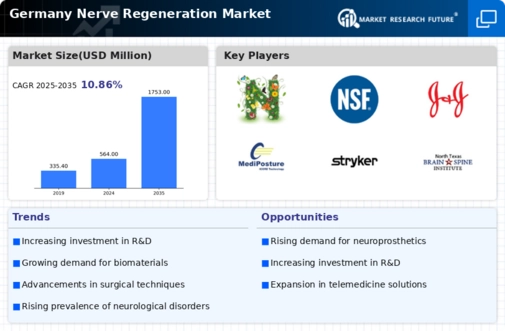The Germany Nerve Regeneration Market has been increasingly dynamic, characterized by a significant influx of innovative technologies and solutions aimed at addressing nerve injuries and conditions.
The competitive landscape in this sector is marked by the presence of various players who are vying for market share through strategic initiatives such as research and development, collaborations, and partnerships.
The growing focus on neurodegenerative diseases, coupled with an increasing aging population that is more susceptible to nerve injuries, has further contributed to the market's evolution. Competitive insights into this sector reveal that companies are prioritizing advanced methodologies and products that enhance nerve regeneration capabilities, making the landscape increasingly complex yet favorable for growth.
Medtronic has successfully positioned itself as a significant player in the Germany Nerve Regeneration Market, leveraging its extensive portfolio and strong reputation in the medical technology industry. The company is recognized for its pioneering solutions that target peripheral nerve injuries and has made considerable investments in research aimed at improving patient outcomes.
Medtronic’s strengths lie in its advanced product offerings, particularly in neurostimulation and regenerative therapies, which are tailored to meet the specific needs of the German healthcare system.
Furthermore, the company's established distribution networks and collaboration with local healthcare providers bolster its presence in the market. The focus on innovation and quality ensures that Medtronic maintains a competitive edge while contributing to advancements in nerve regeneration technology in Germany.
Abbott Laboratories also plays a crucial role in the Germany Nerve Regeneration Market, renowned for its innovative products and comprehensive healthcare solutions. The company is dedicated to developing cutting-edge technologies that promote nerve healing and restoration, setting itself apart through a focus on synergy between life sciences and neurology.
Abbott’s key offerings in this space include advanced imaging technologies and nerve monitoring devices, which are gaining traction in facilitating better diagnostic and treatment methodologies. The company’s strengths include its robust research capabilities, strategic partnerships, and a commitment to patient-centered care.
Additionally, Abbott's mergers and acquisitions have enabled it to expand its product lines and enhance its technological expertise within Germany, fostering a favorable market presence that drives continued growth and development in nerve regeneration solutions.



















Leave a Comment